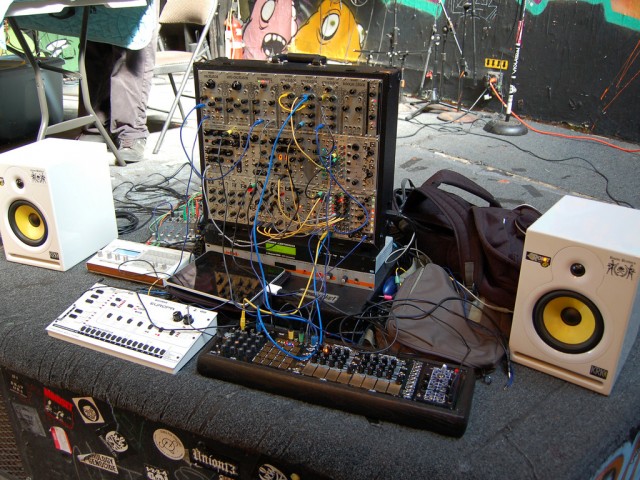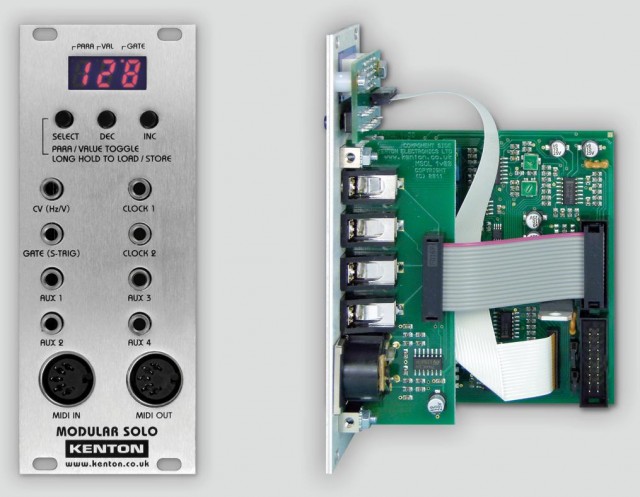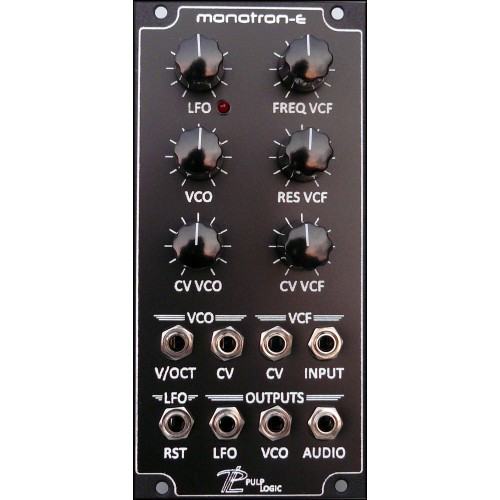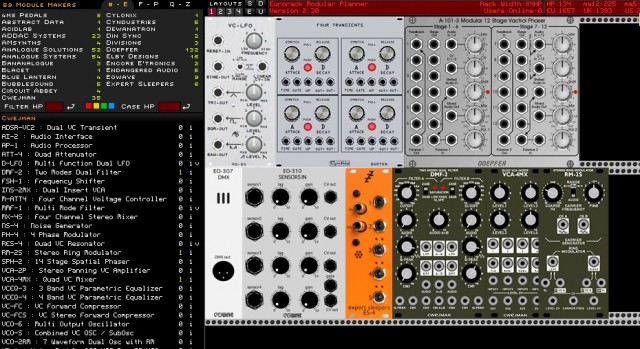Modular music making is a throwback to the early days of electronic music, in which a spaghetti of patch cords is the price of open-ended sound creation. Fairly or unfairly, it has often been viewed as the domain of the eccentric wealthy musician. You needed cash, endless patience, and lots of space – well, unless you happened to be lucky enough to pick up a vintage modular as people were getting rid of them.
But something has happened: modules have become more practical and accessible. Like any music technology, they can become a rabbit hole into which time and money fall and no music escapes. But also like any music technology, there are ways of bending these tools to your will, applying fiscal and creative discipline to make them musically productive.
Enter the “desktop modular” revolution. Modules are cheaper and more usable. It’s easier than ever to assemble a rig of modular that coexists with your digital gear, be it MIDI hardware or computers. That means just a select set of modules within your budget (and available physical space) could find a place. And modules are more innovative and fun than they’ve been in the past, too. They merge digital and analog tech – just as this site has loved doing (despite our name) over the years.
And just as suddenly, that spaghetti entree starts to look delicious.
I can’t say I’ve personally found room for this kind of gear, but I’ve enjoyed watching the evolution of new equipment. And over the past few months, I’ve witnessed a bumper crop of terrific new modules. It’s time to survey some of that fertile landscape, as 2011 winds to a close. Here are a few of my favorites, sure to inspire other nominees from readers. And I imagine this adds fresh cause to venture into the basement stalls of the Winter NAMM music manufacturer trade show in Anaheim next month, where these sorts of less-mainstream devices flourish.
Notably, these modules all work with the ‘small’ Eurorack (A100) format. German maker Doepfer Musikelektronik popularized this format, and it has since taken off. In fact, that puzzled quite a few readers when Moog’s re-entry in modular eschewed that format. (That may be their loss.) But Moog ladder filters aside, there has been plenty of action in the Eurorack space.
Utility: Kenton MIDI-to-CV and More
Kenton’s Modular Solo is about as nice a utility knife as you could add to a modular rig, for integrating lots of different gear. Plug it in via ribbon cable, and you get:
- MIDI in and out
- SYNC 24 (“DIN SYNC” – think 808 and 606 drum machine sync)
- CV analog and gate output
- Two clock outs, four aux outs (think assigning MIDI to filter cutoff, etc., says Kenton)
- And an LFO – triangle, saw up and down, square, S&H pulse width with several fixed widths
£195.00, though all the extras there easily could make it worth it.
Utility: Expert Sleepers ES-4 Modules
Expert Sleepers’ ES-4 is the latest of their modules, turning a standard S/PDIF signal into five channels of control voltage. Coupled with their Silent Way software, you can also use it for MIDI, only with sample-accurate timing. That makes it a sample-accurate MIDI interface, if you like. (See video at top for a MIDI demo.) You can turn three of those five outputs into any signal you like – gate, envelope, LFO, and so on.
Where do you get that S/PDIF output? Well, lots of audio interfaces have them, and many computers – including recent MacBooks – do, as well.
There’s also an ES-4 Gate Expander add-on for additional 8 on/off gates, triggers, clocks, and so on. The unit is £151, or £64 for the Gate Expander, not including VAT.
http://www.expert-sleepers.co.uk/es4.html
More demos:
Sound Sculpting: ADE-10 Reactive Shaper
Justin Owen of Abstract Data sends us this creation. It’s an all-analog waveshaper, wavefolder, feedback unit, with audio to LFO range. That means you can use it as an LFO or design sounds or manipulate synth pads or … any number of things. In fact, it’s nice enough that I could see using it alone, sort of Moogerfooger / stomp style. This is the same nice gentleman who created the Kicker, a synth focused on bass drums.
Loads of sound samples on SoundCloud, in addition to the video tutorial and demo above. It’s yours for £135.00, which I think is quite a bargain.
http://www.abstractdata.biz/ade10/
ADE-10 Reactive Shaper Eurorack Module (2011) by abstractjuz
Synthesis: Monotron in a Eurorack
A bit more left-field, but you can even get Korg’s simple-but-fun Monotron synth in a Eurorack module. Skip ahead in the video below to hear it in action. (Well, unless you prefer field recording crinkly wrapping sounds, in which case the unboxing portion of the video will be your favorite. Toddlers, dogs, and gear lovers agree: unboxing is the best part.)
US$249 puts the Monotron in a rack format. Of course, there, you can do quite a lot more with the Monotron than you can with the original, with both full CV and MIDI control and very, very nice knobs, in place of the awful-feeling (though stunningly inexpensive) controls on the original. All together, that makes a very playable, very fine synth.
http://erthenvar.com/store/monotrone, as seen on Synthtopia
Synthesis: Triangle Core Oscillators
Just when you think you can’t innovate in something as simple as an oscillator — you can.
Synthesist Danjel van Tijn sends news of the Dixie VCO, which, named for its creator, reimagines how to do a triangle oscillator:
It is a triangle core oscillator in Eurorack format that utilises a brand new method of implementing a triangle core oscillator using a design by professor David G. Dixon.
Side note: Trianglecore would make a great genre name.
Professor Dixon co-designed the module and collaborated on its construction. In the video at top, you can see what those waveforms look like. Below, you can see how this might work in a musical context:
Melodic demo of the Dixie VCO. Two Dixies are used (only one at first) along with a Z8000 for sequencing, a uScale for quantizing, uStep for step sequencing and everything is filtered through the new Dr. Octature VCF/VCO.
The uScale is used to help demonstrate the extremely wide and accurate range of tracking of both VCOs. The sequence spans many octaves but the intervals of the two Dixies stay in tune.
PWM, LIN FM and Sync are all played with along with different combinations of waveforms to explore just some of the timbre possibilities.
And here’s what happens when you reverse sync:
We seem to lack purchase info on this particular module for now, but there are loads of other great modules from this Vancouver, Canada-based builder – and yes, they work with Max/MSP and computers, too, not just modules:
Roundup of Other Great Picks
Knowing I could never keep up with all that’s happening on the Eurorack scene, I asked Danjel aka Intellijel to give us some of his picks for some of the coolest modules. He obliged with a drool-worthy – and I dare say genuinely musical – list. Here are his favorites:
There is so much stuff! Eurorack has obviously tried to update or recreate most of the classic synthesis blocks from various manufacturers (Buchla, Moog, Roland etc. etc.) but the past couple of years very interesting developments have been made incoporating brand new designs not found anywhere else. Some of these are completely DSP based, some are hybrids and some like the Dixie VCO are %100 analog.
Other stuff I have put out that is unique (and actually has decent video) would include:
uScale: CV quantizer but it also does intelligent interval generation
Corgasmatron:
This is a dual multimode filter with the same transfer function as classic Korg MS20 but it is a completely new circuit design (nothing related to the original at all) using all modern components.
On the analoghaven page there is a list of about 40 manufacturers each with many modules:
http://www.analoguehaven.com/what/The Muffwiggler.com forum is extremely active with all things to do with modular synthesis (and synths in general).
Stuff worth noting form other manufacturers (there is so much more from each of these groups):
Cylonix Cyclebox:
FPGA based extremely deep triple VCO with through zero FM and massive amount of synthesis and waveshaping options
http://www.cylonix.com/cyclebox.htmlTipTop Audio matrix sequencer:
http://www.tiptopaudio.com/z8k.php?goto=featuresTiptop Audio Z-DSP (user programmable DSP fx processor)
http://www.tiptopaudio.com/zdsp.php?goto=featuresExpert Sleepers ES-3 (all their products really) control your analog gear via a plugin in Ableton/DAW and their lightpipe/spdif/db25 connector
http://www.expert-sleepers.co.uk/es3.htmlKilpatrick Audio K4815 Pattern Generator
http://www.kilpatrickaudio.com/?p=K4815Makenoise Phonogene: digital tape recorder re-visioned
http://www.makenoisemusic.com/Phonogene.htmlMakenoise Rene: cartesian sequencer
http://www.makenoisemusic.com/RENE.htmlSynthesis Technology Morphing Terrarium: morphing wavetable synthesis
http://www.analoguehaven.com/synthesistechnology/e350/Synthesis Technology Deflector Shield: thru-zero frequency shifter, phaser and ring mod
http://www.analoguehaven.com/synthesistechnology/e560/The Harvestman Double Andore: dual a-d envelope generator and 2-channel vca with digital curve shaping and vca law selection
http://www.theharvestman.org/2017.phpThe Harvestman Bionic Lester: dual 12db/oct switched capacitor multimode filter with mode selction and clock disruption.
http://www.theharvestman.org/1873.phpToppobrillo Sport Modulator: Dual VC Lag and CV processor
http://www.analoguehaven.com/toppobrillo/sportmodulator/
Thanks, Danjel! This looks fantastic – plenty to consider as inspiration.
It all makes me wish for a holiday on which some supernatural being, against all rules of material consumption and the conservation of physics, flies around the Earth leaving, for free, the things you desire as gifts. If someone can make this happen, let me know. Also, I’ll need the contract to a flat in which I can house said materializing goods. Until then, I’ll have to hack something together for free in Pd and run it on a netbook.
Dream On: Modular, The Movie, and the Planner
Modular remains such a cultural phenomenon, it has inspired its own movie project, as seen on IndieGogo (trailer above):
I Dream of Wires: The Modular Synthesizer Documentary
If we’ve sold you on this whole idea, Danjel also points us to this:
There is a pretty cool online interactive virtual modular for planning out a system
It contains pretty much every module available.
http://www.modularplanner.co.uk/
More analog…
By the way, if you appreciate this sort of analog coverage and would like a domain at which you can see it, you should complain to Trash Audio. They cheekily registered the createanalogmusic.com domain and redirected it to their site, and they haven’t responded to offers to buy it from them them. I suggest you flood their inbox with complaints until they aquiesce. Alternatively, perhaps you can think of a word that means analog but begins with the letter ‘D,’ as that’d fit nicely with the ‘CDM’ acronym. Or we could come up with something in another language – German, for instance.
I’ve registered createanalogmusic.de for now; I’ll point it at something later this week. And as for how we can get back at TRASH_AUDIO — I’m open to suggestions. Can’t crash their NAMM party; I’ll be on a flight back to Berlin. (Seriously, that crew held a great synth meetup in LA in September I was lucky enough to catch – at least briefly.)
We’ll continue to happily bring you judgment-free electronic music making on a variety of platforms, from the Apple II to a discarded, broken cell phone to analog circuitry you wired up yourself, because that’s how we roll.




